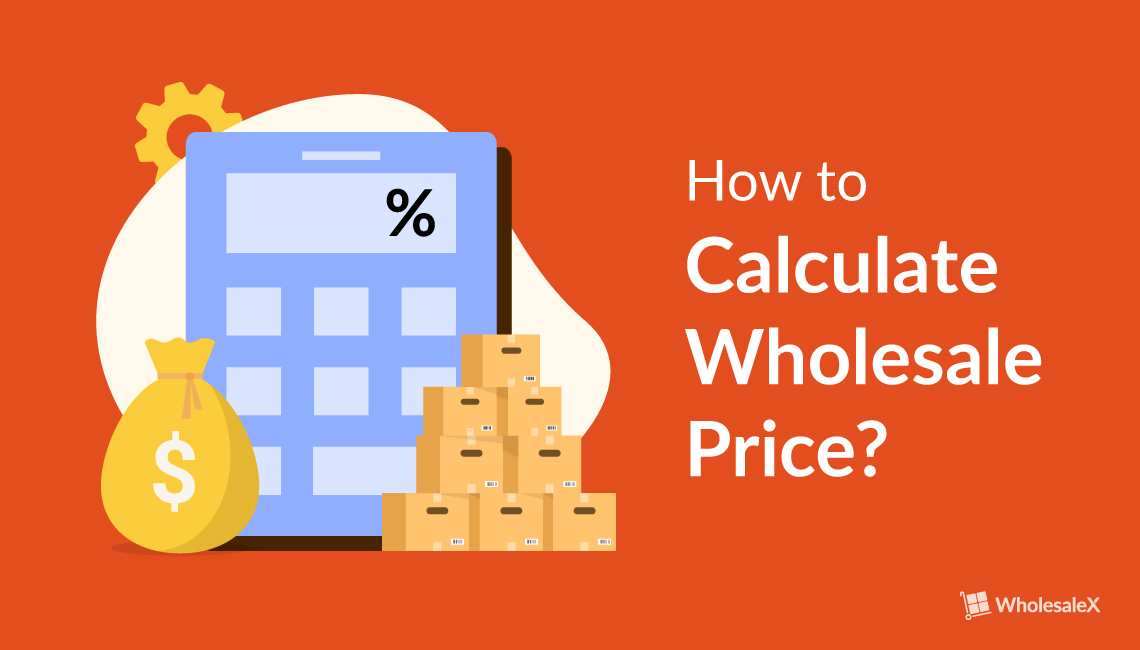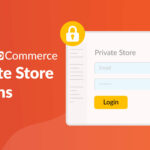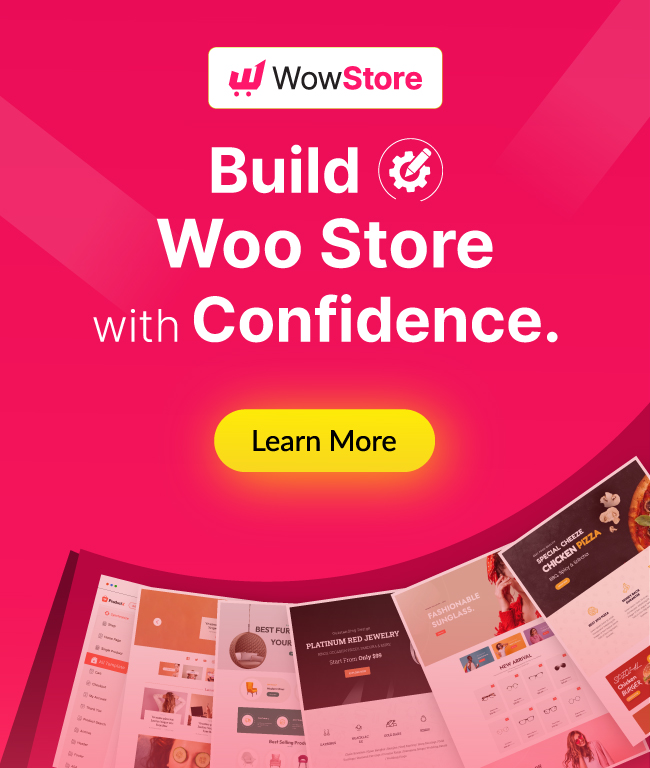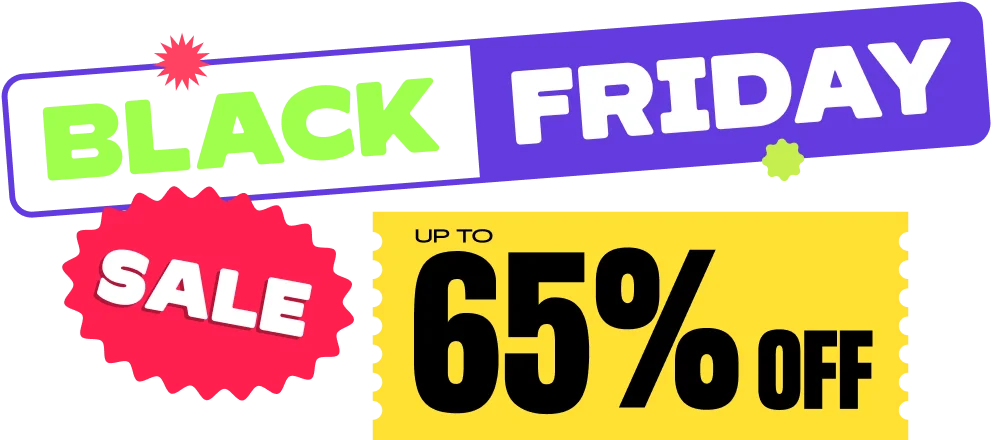How to Calculate Wholesale Price (Quick Breakdown)
To calculate the wholesale price, use this simple formula:
Wholesale Price = Cost of Goods Manufactured (COGM) + Customer Acquisition Costs (CAC) + (COGM × Desired Profit Margin %)
Follow these steps:
1. Calculate Your COGM
This includes:
- Materials: Raw materials and components.
- Labor: Wages, overtime, and other worker costs.
- Overhead: Rent, utilities, equipment, and other expenses.
📌 Example: $100,000 (materials) + $50,000 (labor) + $30,000 (overhead) = $180,000 COGM
2. Add Customer Acquisition Costs
Include marketing, advertising, events, and your own time spent acquiring buyers.
3. Decide on Profit Margin
Wholesale margins typically range between 30%–50%.
- Example: If COGM is $50 and you want 40% profit → $50 + ($50 × 0.40) = $70 wholesale price.
4. Consider Market Factors
- Competitor Pricing: Stay competitive but profitable.
- Retail Markup: Retailers need their margin too (often 50% or more).
- Scalability: Ensure the price works for bulk orders.
Did you know that 60% of small businesses struggle with pricing, often due to inaccurate wholesale pricing strategies?
Pricing is a vital aspect of any wholesale business, but it can also be one of the most challenging. Striking the perfect balance between profit margins and customer satisfaction is a delicate art.
Set the price too high, and you risk driving away potential buyers; set it too low, and you may undermine your product’s value and profitability. As a wholesale business owner, finding the right pricing strategy is crucial for long-term success.
In this comprehensive guide, we’ll explore everything you need to know about wholesale pricing, from the determining factors to the best pricing strategies and the formulas you can use to calculate wholesale prices accurately.
Whether you’re just starting or looking to improve your pricing strategy for new products, this guide will give you the knowledge and tools you need to make informed decisions and optimize your results.
Let’s dive in and master the art of wholesale pricing!
What is the Wholesale Price?
When you hear the term wholesale price, think of it as the price businesses pay when they buy goods in bulk. It’s the cost of getting a product from the manufacturer or distributor, usually at a much lower price than the retail price.
Why? Because wholesalers are selling in larger quantities, which means they can offer discounts.
Let’s say you’re selling handmade candles. Each candle costs you $5 to make. You sell these candles to local shops at a wholesale price of $10 each. The shop then sells them to customers for $20.
How is Wholesale Price Different from Retail Price?
Okay, so we know what the wholesale price is now. But how does it differ from retail price? Let’s break it down:
Who’s Buying?
- Wholesale: Businesses buy in bulk to sell the products at a higher price.
- Retail: Consumers buy in smaller quantities (one candle, one shirt, etc.) for personal use.
Price Tag:
- Wholesale: The price is lower because you’re selling in large amounts, so businesses get a better deal.
- Retail: The price is higher to cover things like store rent, employees, and, of course, to make a profit.
Why Buy?
- Wholesale: Businesses buy to resell the products at a markup.
- Retail: People buy for personal use – they’re not reselling the items.
Who It’s For:
- Wholesale: Aimed at retailers and distributors.
- Retail: Aimed at the end consumer.
Knowing about wholesale pricing is super important, whether you’re buying or selling. If you’re a business owner, setting the right wholesale price means you can stay competitive while making sure you’re still making a profit.
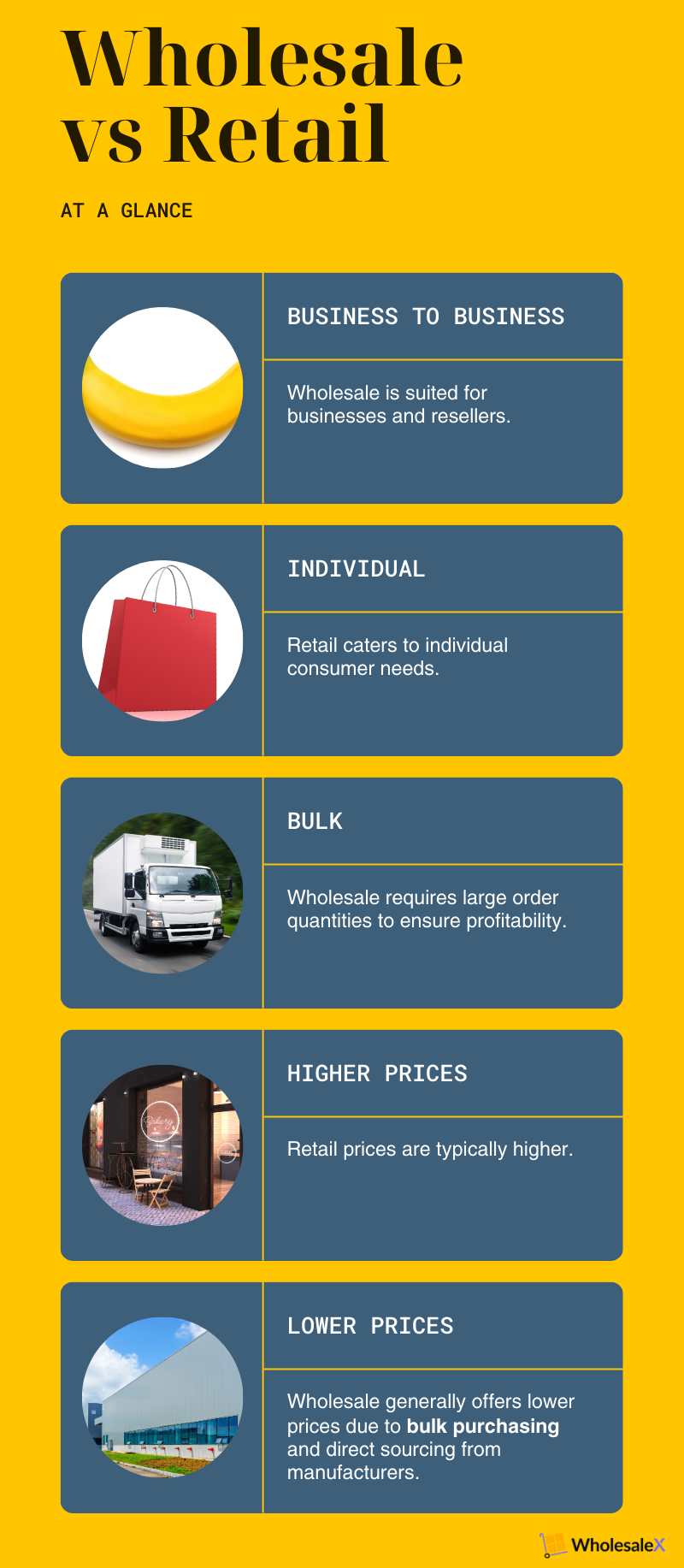
It’s all about getting that sweet spot where you can sell enough to grow your business, but still keep things profitable!
Things to Consider While Determining Wholesale Price
Analyze Market Conditions and Competitor Pricing
Before deciding on your wholesale price, it’s important to analyze the market and competitor pricing. You need to understand the demand for your product and how competitors are pricing similar items.
For example, if you’re entering the smartphone industry, look at how competitors are pricing their products. If other brands are charging $550 for a similar smartphone with premium features, you may have the opportunity to set your price lower around $450 to offer better value, without sacrificing product quality.
Consider things like customer preferences, market trends, and even economic factors that might affect pricing. This helps you gauge where your product stands and how to price it competitively.
Fixed and Variable Costs
Another key consideration is understanding your costs both fixed and variable.
Fixed costs are the expenses you incur regardless of how much you sell, such as rent, utilities, and salaried employees. Variable costs fluctuate based on your production and sales volume, like materials and shipping.
The important thing here is to calculate both types of costs accurately, as they play a huge role in determining your wholesale price. Fixed costs are typically harder to adjust, but with variable costs, you have more flexibility. You can adjust your prices based on actual production levels to improve profitability.
Total Production Costs of Goods
The Cost of Goods Manufactured (COGM) includes everything involved in the production of your product from materials and labor to overhead expenses.
When setting a wholesale price, you need to account for all of these costs to ensure you’re covering expenses and making a profit.
If the cost to produce an item is $180,000 (materials, labor, and overhead), you’ll need to price it above that to avoid losing money. Understanding COGM helps you determine a minimum selling price to cover costs and achieve the desired margin.
Customer Acquisition Costs
Customer Acquisition Costs (CAC) often get overlooked in wholesale pricing, but they’re crucial. These costs refer to how much you spend to acquire a new customer, including marketing expenses, advertising, and even sales efforts.
When determining your wholesale price, don’t forget to include the CAC in the equation.
If it costs you $20 to acquire a customer, that’s an additional cost to account for when setting your price. This ensures you’re not just covering production costs but also your efforts to gain new customers.
Profit Margin
Finally, you need to consider your profit margin. A healthy profit margin is essential for sustaining your business. Most wholesalers aim for a 30%-50% profit margin, depending on the industry and market.
It’s important to balance your cost structure with a margin that reflects your business goals while remaining competitive. If you’re pricing too low, your margins could be too tight, and if you’re pricing too high, you risk losing customers.
Different Methods For Calculating Wholesale Price
Wholesale pricing strategies vary among businesses, with factors such as market research findings and business goals influencing the chosen approach. Here are some pricing methods you can consider implementing in your wholesale business.
Cost-based pricing
Cost-based pricing, also known as cost-plus pricing, is a straightforward strategy where you incorporate all your manufacturing or procurement costs into the price of your product. By adding a markup on top of these costs, you ensure consistent returns as long as the costs remain stable.
However, one drawback is that if the costs change, you may need to adjust your wholesale price accordingly. Additionally, this pricing strategy does not consider external factors like competition or demand patterns. Despite its simplicity and consistency, it may not fully account for market conditions.
Differentiated pricing
This pricing is a flexible demand-based strategy that allows you to adjust your prices according to different situations. You can set a price above the average market figures in low competition scenarios.
Conversely, if your goal is to generate quick sales, you can choose to set a price below the market average. Another option is offering reduced pricing for customers purchasing higher quantities. While this strategy provides adaptability, it requires agility and the ability to make quick changes.
Value-based pricing
Value-based pricing focuses on determining what customers are willing to pay for a product, with the aim of setting higher prices. If research indicates that customers consider your products luxurious or high-value, you can establish a premium price.
This strategy leverages the willingness of customers to pay more for products they perceive as valuable. However, it is essential to note that setting high prices may limit your market size.
Competitive/market-based pricing
Competitor-based pricing uses competitor pricing as a reference point. You can either match your competitors’ prices or set lower prices to attract more wholesale buyers. This strategy is most effective in industries with similar products, like smartphones.
By effectively managing costs and selling at a lower price, you have the potential for high sales and profits. However, this strategy may be challenging for smaller wholesalers or those who are new to the market.
Bundle pricing
Have you ever noticed this pricing method in promos or stores? It offers two or more products at a single price, often with slight price reductions, creating the perception of value.
Proven effective, Nintendo boosted sales by bundling a game with their Game Boy console.
However, bundle pricing demands caution. Insufficient sales could lead to losses. Requiring a minimum order quantity from retailers can mitigate risks
Also Read: How to Create Bundle Discounts in Woocommerce
How to Calculate Wholesale Price: Calculating with Formulas
Setting the right wholesale price is critical to the success of your business. You want to make sure you’re covering all your costs while also earning a healthy profit.
Here’s a simple, step-by-step guide to help you calculate your wholesale price using formulas.
Calculate your total cost of goods manufactured (TCGM)
Start by adding up all the costs involved in making or procuring your product. This includes:
- Labor costs: What you pay your team for manufacturing or assembling the goods.
- Overhead costs: Things like rent, utilities, and any other indirect costs.
- Materials costs: The cost of raw materials or parts used in the product.
- Capital costs: Equipment, machinery, or any fixed assets used in production.
So, the formula looks like this:
labor + overhead + materials + (any other applicable costs) = TCGM
Determine the average cost of goods manufactured (ACGM)
You can calculate this by dividing the TCGM by the number of units manufactured. It is calculated as follows:
TCGM / number of units = ACGM
This tells you the cost of manufacturing each individual product.
Decide your profit margin
The profit margin is what you aim to make on each product. Typically, wholesalers target a profit margin of 30% to 50%. This is your gross profit that you add on top of your cost price.
You can express your profit margin as a percentage. For example, if you’re targeting a 40% profit margin, you’ll use 0.4 in the next calculation.
Learn more about gross profit margin for a wholesale coffee roaster.
Finally, determine the Wholesale Price
Now that you know the average cost per unit (ACGM) and your desired profit margin, it’s time to calculate the wholesale price.
Here’s the formula:
ACGM / (1 – Profit Margin Percentage) = Wholesale Price
So, you take your average cost and divide it by (1 – profit margin). Alternatively, you can multiply the ACGM by 1 / (1 – profit margin).
Example: Calculating Wholesale Price
To begin calculating the wholesale price, we need to determine the Total Cost of Goods Manufactured (TCGM). The costs of procurement will be $10,000 + $1,000 + $2,000 = $13,000.
Next, we calculate the Average Cost per Good Manufactured (ACGM), which will be $13,000 / 100 = $130.
Now comes determining the desired profit margin percentage. In this case, ABC Electronics aims for a 40% profit margin.
Based on these figures, we can calculate the wholesale price by dividing the ACGM by (1 – 0.4) or multiplying the ACGM by 1 / (1 – 0.4).
This results in a wholesale price of $130 / (1-0.4) = $216.67.
Also Read: How to Set Wholesale Prices in WooCommerce
Choosing the Best Pricing Strategy for Sustainable Growth in Your Business
Crafting a successful wholesale pricing strategy is no small feat. It’s a dynamic, ongoing process that requires constant adjustments and experimentation to find that sweet spot for your products.
Pricing isn’t a one-time decision it’s a journey that involves continuous refinement based on market trends, customer behavior, and competitor actions.
Think of it like balancing on a tightrope: you need to stay flexible and make small adjustments to maintain your balance.
Similarly, your pricing strategy needs to be adaptable, adjusting based on market conditions, customer demand, and competitor pricing. It’s all about staying in tune with the market while ensuring profitability.
How Accurate Pricing Drives Growth and Profitability
Accurate pricing is key to unlocking sustainable growth.
When you set the right price, you’re not just covering costs and making a profit you’re creating value for your customers and building trust. This trust encourages repeat purchases, brand loyalty, and positive word-of-mouth, all of which fuel long-term success.
- Competitive Advantage: By analyzing your competitors and staying aligned with market demand, you can adjust your pricing to stay competitive and attractive to customers.
- Maximizing Margins: Setting the right price helps you maintain healthy profit margins. Price too low, and you might sell more, but you’ll lose money. Price too high, and you risk losing customers.
According to a McKinsey & Company study, businesses that use pricing strategies based on real-time data see a 2-7% increase in revenue in the first year of implementation.
Common Mistakes to Avoid in Wholesale Pricing
Pricing your products correctly is a game-changer for your business. But even the most seasoned wholesalers can make mistakes that hurt their bottom line. Let’s walk through some common pricing missteps and how you can avoid them.
| Mistake | Description | Why It’s a Problem | How to Avoid It |
|---|---|---|---|
| Underpricing | Setting prices too low to attract customers. | You may lose out on profit, making it hard to sustain your business. | Know your costs and set a price that covers them while allowing for profit. |
| Overpricing | Setting prices too high compared to competitors or the market value. | You risk losing customers who find better deals elsewhere. | Research your competitors and adjust your prices to remain competitive. |
| Ignoring Costs | Failing to consider all costs, including overhead, labor, and shipping. | This can lead to setting prices that don’t cover all your expenses. | Calculate all costs, including hidden ones, to ensure your price covers everything. |
| Not Accounting for Volume Discounts | Not adjusting prices for larger orders or bulk buyers. | You miss opportunities to incentivize larger purchases and increase sales volume. | Offer bulk discounts to attract larger orders and increase overall sales. |
| Ignoring Market Trends | Not adjusting prices according to shifts in supply and demand. | You may miss out on maximizing profits during high-demand periods. | Keep an eye on market trends and adjust your prices accordingly. |
| Neglecting Profit Margins | Setting prices without considering desired profit margins. | You might set a price that barely covers costs, resulting in low profitability. | Always ensure your pricing reflects both your costs and your desired profit margin. |
| Not Testing Prices | Settling on a price without testing its effectiveness in the market. | You may not know if your price is too high or too low until it’s too late. | Test different price points and analyze customer responses before finalizing your pricing. |
TL;DR:
- Don’t underprice and undervalue your product.
- Avoid overpricing, which can scare away potential customers.
- Always account for all costs involved in your pricing.
- Consider market demand and customer expectations.
- Keep your prices flexible and adjust when needed.
💡 Pro Tip
If you’re unsure about your pricing strategy, get feedback from trusted customers or mentors. Sometimes, a fresh perspective can help you see things you might have missed!
FAQs
What is the difference between wholesale and retail pricing?
Wholesale pricing is for businesses purchasing goods in bulk to resell at a higher price to consumers, while retail pricing is what the end consumer pays when purchasing products directly from stores.
How do I set a profitable wholesale price?
To set a profitable wholesale price, calculate your total cost (including production, shipping, and overhead), and add a reasonable profit margin. Always research your competitors’ pricing to ensure you’re competitive.
Can I change my wholesale price over time?
Yes! You can adjust your wholesale price as market conditions change, including fluctuations in production costs, demand, or competitor pricing.
How do I use a wholesale price calculator?
Simply input your product’s cost and desired profit margin into a wholesale price calculator. The tool will automatically calculate the best wholesale price for you, taking into account production costs and profit goals.
What pricing strategies should I use for my wholesale business?
Common pricing strategies include cost-plus pricing, market-based pricing, and value-based pricing. Choose the one that best suits your business model and market conditions.
How WholesaleX Makes Pricing Easy for Wholesalers

WholesaleX is a powerful WooCommerce plugin designed to streamline wholesale pricing and enhance your B2B operations. Here’s how it simplifies pricing for wholesalers:
WholesaleX allows you to set customizable pricing rules based on user roles, order quantities, or specific products. This flexibility ensures that your pricing strategy aligns with your business model.
Tiered Pricing Structure
Implementing tiered pricing is straightforward with WholesaleX. You can create multiple pricing levels to incentivize bulk purchases, encouraging larger orders and increasing average order value.
Custom User Roles and Permissions
WholesaleX enables you to define custom user roles with specific permissions, ensuring that different customer groups receive appropriate pricing and access.
Request a Quote Feature
The ‘Request a Quote‘ feature allows customers to negotiate prices, providing flexibility and fostering better customer relationships.
Comprehensive Documentation and Support
WholesaleX offers detailed documentation and video tutorials, making it easy to set up and manage your wholesale pricing strategies.
Conclusion
Setting the right wholesale price is crucial for the success of any wholesale business. By understanding the factors that influence pricing, choosing the right pricing strategy, and avoiding common pricing mistakes, you can ensure profitability while staying competitive.
Tools like WholesaleX make pricing easier and more efficient by offering customizable features, tiered pricing, and seamless integration with your existing systems.
As you move forward, remember that accurate pricing is not a one-time decision but an ongoing strategy. Use the tools and strategies discussed here to optimize your pricing, track performance, and adjust as needed to maintain long-term growth.
Don’t let pricing overwhelm you start using the right tools today and take control of your wholesale business’s success!
For more helpful tips, stay connected with our LinkedIn Newsletter.

